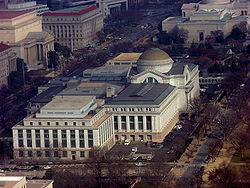National Museum of Natural History
The National Museum of Natural History is a natural history museum on the National Mall in Washington, D.C., United States. It is administered by the Smithsonian Institution. Admission is free and the museum is open 364 days a year.
| National Museum of Natural History | |
|---|---|
 Main facade | |
| Established | 1910 |
| Location | National Mall in Washington, D.C., United States |
| Type | Natural History |
| Visitor figures | 6 million (2017)[1] |
| Director | Kirk Johnson |
| Public transit access | |
| Website | www |
The museum's collections total over 500 million specimens of plants, animals, fossils, minerals, rocks, meteorites, and human cultural artifacts (made objects). With 7.4 million visitors in 2009, it is the most visited of all of the Smithsonian museums.[2] It is home to about 185 professional natural history scientists – the largest group of scientists dedicated to the study of natural and cultural history in the world.
The main building includes a popular "Insect Zoo" and an IMAX theater.
Collections and research
The museum includes a collections storage facility in Suitland, Maryland. The museum has a marine science research facility in Ft. Pierce, Florida, and field stations in Belize, Alaska, and Kenya. The museum has seven research departments:
- Anthropology
- Botany
- Entomology
- Invertebrate zoology
- Mineral sciences
- Paleobiology
- Vertebrate zoology
Staff collect specimens of fossils, minerals, rocks, plants and animals, tools and artworks. There are a total of 5,285,754 on-line specimen records are available from this work, and a total of 126 million individual specimens.[3] Trained people look after these finds, and keep the collections in good condition.
The NMNH claims to have the largest, most comprehensive natural history collection in the world.[3]
Links with other organizations
The museum has research links with a number of U.S. government agencies, which have staff working with and at the museum. These include the Department of the Interior (U.S. Geological Survey Biological Resources Division), the Department of Agriculture (Systematic Entomology Laboratory), the Department of Commerce (National Marine Fisheries Service Systematics Laboratory), and the Department of Defense (Walter Reed Biosystematics Unit).[4]
National Museum Of Natural History Media
The museum as seen from the National Mall
The Star of Asia, a large, 330-carat cabochon-cut star sapphire in the U.S. National Gem and Mineral Collection
Deep Time exhibit, prominently featuring skeleton of Diplodocus
Tyrannosaurus rex in the Deep Time exhibit, depicted preying on Triceratops
A FossiLab volunteer uses lab equipment to sift through collected sediments for bone particles at the Smithsonian National Museum of Natural History.
References
- ↑ "Visitor Statistics". Smithsonian Newsdesk. Archived from the original on 9 February 2018. Retrieved 23 March 2018.
- ↑ Zongker, Brett (January 5, 2010). Smithsonian reports 20% jump in museum visitors. USAToday. https://www.usatoday.com/travel/destinations/2010-01-05-smithsonian-visitors_N.htm. Retrieved 2010-07-05.
- ↑ 3.0 3.1 "National Museum of Natural History official website". Archived from the original on 2016-02-22. Retrieved 2011-11-23.
- ↑ "About the Museum". Archived from the original on August 15, 2012. Retrieved November 23, 2011.








